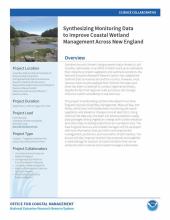
Sea level rise and climate change present major threats to salt marshes nationwide. In an effort to better track and understand their impacts on marsh vegetation and sediment accretion, the National Estuarine Research Reserve System has established Sentinel Sites at reserves around the country. However, most reserves have not yet analyzed their Sentinel Site data, and there has been no attempt to conduct regional syntheses, despite the fact that regional-scale processes can strongly influence marsh vulnerability to sea level rise.
About this resource
This project overview describes how a 2018 Catalyst project led by the University of New Hampshire is synthesizing Sentinel Site data for four New England reserves (Great Bay, Narragansett, Waquoit Bay, and Wells), which have individually been monitoring salt marsh vegetation and elevation changes since at least 2011. Using Sentinel Site data sets, the team will develop statistics-ready data packages linking vegetation change with surface elevation and other data, including output from an inundation tool. The New England reserves and coastal managers will be equipped with new information that can inform and improve the management, protection, and restoration of salt marshes. The overview highlights the project approach, anticipated benefits, anticipated products, and targeted end users.